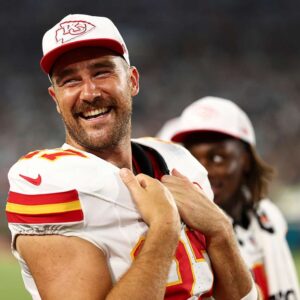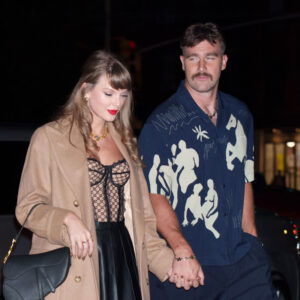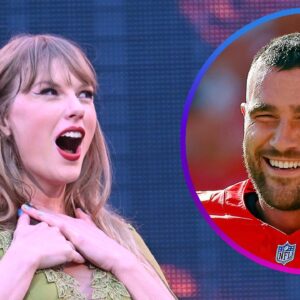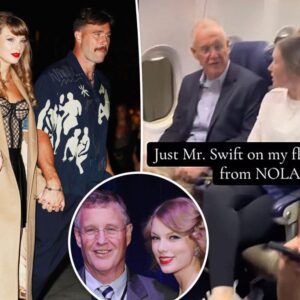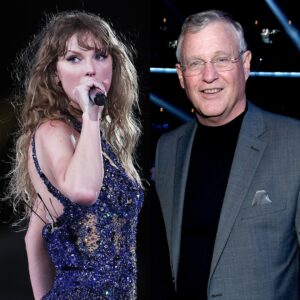
We might have gotten the “Taylor Swift Effect” all wrong.
One year ago, as of this Tuesday afternoon, the pop superstar attended her first Kansas City Chiefs game at the invitation of tight end Travis Kelce.
Over the ensuing days, the NFL posted about Swift 34 times on its social channels, generating 170 million impressions. Kelce’s jersey sales jumped 400% as the NFL saw a record number of purchases across its product line. The Chiefs’ Instagram following grew by more than 200,000, even though the team took a relatively hands-off approach to commenting on the budding romance.
“We hear the stories, we see the data, people are talking about the game that weren’t talking about the game yesterday,” NFL commissioner Roger Goodell said of Swift’s impact before Super Bowl LVIII, which drew a record 123.7 million average viewers thanks to a 24% jump in 18- to 24-year-old women tuning in for KC’s win. “And whatever that reason is, I’m good with it.”
The standard retelling of Swift’s impact on the NFL goes like this: Highly influential celebrity publicly watches football, implicitly encouraging her impressionable fanbase to tune in, too. They buy merchandise and learn the game to become fans just like her.
From September 2023 to now, the number of female NFL fans grew by more than four million, according to new data from polling firm YouGov. Chiefs Kingdom alone added an estimated 3.4 million women to its ranks.
But looking back a year later, it seems sports themselves have been swayed as much as any teen. Taylor Swift showed executives that there were millions of young people fully capable of becoming committed sports fans. They were ready. Like Swift herself, all they needed was an invitation. That story has now played out countless times, including away from the gridiron.
Numerous teams have held their own Eras night—a nod to Swift’s ongoing Eras Tour—over the last year, knowing full well that Taylor was never going to show up in person to celebrate, from the University of Utah to Troy to Boston College to Hawaii. Even Iowa’s women’s basketball program joined in, while already having their own mega-star draw in Caitlin Clark.
One of the Rainbow Warriors’ youngest staffers initially suggested their Taylor Swift Night promotion.
“The original conversation was me kind of being a little stand-offish,” Hawaii athletics director of marketing and fan experience Eric Mathews said. “You think it’s a good idea for men’s basketball?” But he quickly came around, ready to experiment.
Mathews said the players weren’t too happy when Swift songs played during warm-ups, but otherwise the night—featuring a friendship bracelet-making station and a halftime lip-sync battle—was a success. Ticket sales among women 18-to-40 jumped roughly 60%.
Hawaii now has new one-offs lined up for this year, like Beyonce and Lion King-themed nights. More significantly, Mathews is still looking to evolve the program’s game-to-game atmosphere. “What you’re doing is you’re not playing ACDC’s Thunderstruck, you’re playing stuff like Taylor Swift and Justin Bieber and Beyonce and whatever’s popular nowadays,” he said. “We’re trying to build and get more, different fans in here.”
Lower-level baseball teams embraced the trend as much as anyone. Several clubs held multiple Taylor Swift-themed nights this summer, often raffling off concert tickets worth thousands of dollars as the main draw.
Twenty miles from Arrowhead Stadium, the Kansas City Monarchs of the American Association of Professional Baseball went further, becoming the “Kansas Swiftie Monarchs” for one game in August. They kept the giveaway process purely physical to avoid any foul play, handing out raffle tickets at the gate and stamping each recipient (with the number 13, naturally) to prevent double-dippers.
Roughly 5,000 fans showed up in total, more than double an average night. A husband, wife and their two young kids took home the grand prize.
“We definitely reached an entirely different market,” Monarchs director of fan engagement and gameday production Morgan Kolenda said. “To see all of them out here, just enjoying the game, it was fun.”
Given how well those events worked out, teams are certain to continue marketing to Swift’s core demographic more often.
The NFL was relatively far along that path before Swift showed up, focusing on growing its female fanbase for the last several years. Flag football offered a way to get more girls playing a version of the sport. Influencer relationships with the likes of social star Alix Earle have translated football culture for new audiences, as did collaborations with Vogue.
“This missing piece was really 35-year-old women and below—the younger demographic—which is exactly in line with Taylor Swift’s fan base,” Rice University faculty and sport finance expert Carrie Potter said. “Not only are the statistics lining up in terms of the demographic that the NFL could go after, but it’s also that the women in those situations control purchasing power.”
In fact, the NFL even helped tight ends including Travis Kelce hand out friendship bracelets to each other for a piece of social content filmed months before he was seen with his new girlfriend.
Swift’s actual entry into the picture only accelerated—and spotlighted—those efforts.
Ian Trombetta, the NFL’s SVP of social, influencer and content marketing, can see first-hand the boost in attention Swift-related posts receive. However, her sudden appearance can cloud some of that ongoing work.
“The reality is that there’s a full marketing mix at play here as to how we’re bringing in women,” Trombetta said. “There’s a lot more at play than just having the Taylor effect.”
Of course she came with backlash, too.
Conspiracy theorists wondered if Swift and Kelce’s relationship was all staged. The merely cynical considered it might be a motivated ploy for attention. Others took issue with the number of times Swift was shown during games or highlighted online. It’s now news when Swift doesn’t go to a game, as was the case with the Chiefs’ Week 3 appearance on Sunday Night Football.
Critiques will continue for as long as the NFL keeps trying to present a monolithic entertainment product for all of its viewers. There’s no way to update the presentation for a growing slice of the audience without upsetting at least some percentage of long-time fans.
But there’s also no turning back. Taylor Swift has sped up a self-reinforcing cycle: More women are watching sports, so sports are doing more to welcome those new spectators, and therefore even more women are tuning in and showing up.
“What we’re learning is … not just that these young women are there because Taylor Swift is there, or they’re buying jerseys because Taylor Swift is wearing them, they’re actually now becoming introduced to the game and there’s a stickiness to it,” Potter said. “If the NFL product is so good, and the women are tied to not just the Taylor Swift effect, but that brings them into the fold and now they stick as a fan, and they stay engaged throughout the different life cycles, then it can only add growth to the NFL and their marketing and branding and sponsorship power.”
Off-field conversations helped the NFL post its best offseason digital engagement numbers this year, Trombetta said, including a record preseason despite competition from the Olympics and the election. TV ratings have continued to climb as well.
“There are very few people on the planet—maybe not any—who have the type of influence that Taylor Swift has right now,” he said. “So yeah, it’d be kind of ridiculous for us not to lean into it and have some fun, right?”
Yes, Swift helped introduce girls to the world of sports. But more significantly, she helped introduce the world of sports to the expanding power of the female fan.
